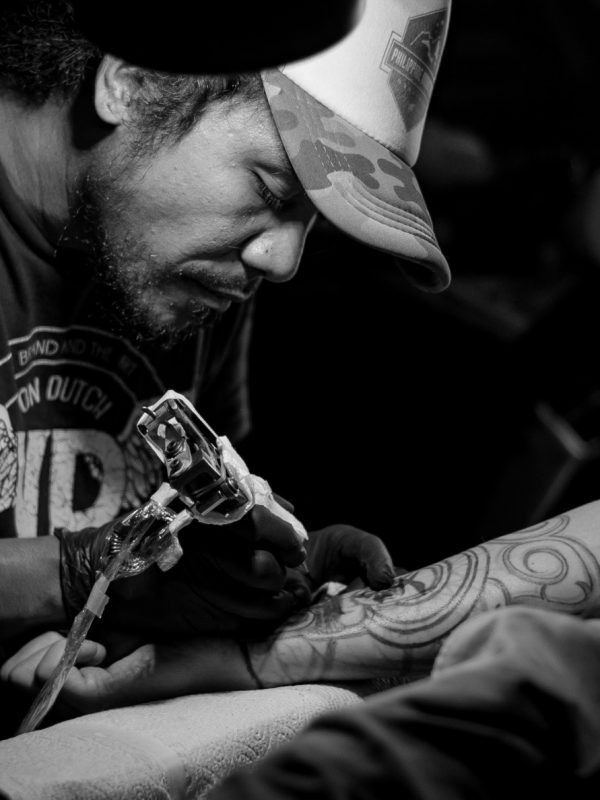I have just one tattoo. It’s on my forearm, it’s quite large...
and it’s of HAL 9000 from 2001: A Space Odyssey – my favourite film of all time. Never seen it? Here’s the gist:
HAL 9000 is a powerful, human-like AI, overseeing a spaceship. HAL loses his marbles, and starts killing off the spaceship’s human crew for “jeopardising the mission” and getting in his way. He efficiently murders every crew member bar one guy, who narrowly escapes death by climbing inside HAL’s ‘brain’ and dismantling it.
Now, I got my HAL 9000 tattoo because I love the movie (which is a lot less dumb than I just made it sound). But in the context of the current hand-wringing, pearl-clutching and pants-shitting over ChatGPT, it feels like I may yet come to regret this tattoo, for tragicomically ironic reasons.
Because: do I really want an unstoppable, super-smart AI inked on my body if an unstoppable, super-smart AI is about to murder my career and ruin my life? Probs, all things considered, not.
However, I’m not tearfully booking myself in for laser tattoo-removal just yet. Because, in truth, I don’t believe that ChatGPT will kill my career. But I’m still keen to mull over the fact that it could, if I don’t adapt. Because I’ve witnessed first-hand what happens when people don’t afford revolutionary new technology the fearful respect it deserves.
Gather ye around now to hear my chilling cautionary tales of yore.

Haunting personal experience one: the iPod
Back in the early noughties, I was a music journalist.
The first iPod was released in 2001, and within a few months, those things – and legions of copycats – were everywhere. This happened fast.
Amongst the young, the iPod’s rise was fuelled by MP3 piracy tools such as Napster, Kazaa and Limewire. Caught napping, the global music industry looked on helplessly as piracy exploded and sales fell off a cliff edge. Billions of pounds and countless jobs were lost. Music magazines I wrote for closed down as their ad revenue withered away. I ate a lot of instant noodles and frequently struggled to pay rent.
For a while there – pretty much until Spotify arrived – it really did feel like the music industry had no feasible way forward. And all because the people at the top were too slow – and arrogant, and naive – to realise what the MP3 era meant. Too many of them assumed that MP3 users would somehow ‘come to see the error of their ways’. But no, it didn’t matter to The Kids that the audio quality of pirated MP3s was crap compared to CDs. And no, The Kids didn’t care that they were breaking the law, constantly.
So while the industry buried its head in the sand, MP3s scuttled round the back and kicked it square in the arse. And that arse still has the big purple bruise to prove it.
Haunting personal experience two: the iPhone
I continued to work in print journalism throughout the noughties. In 2007, the iPhone was launched. The following year, a 3G version arrived, allowing for speedy (at the time) connection to the internet. Suddenly, people no longer needed to purchase and carry around magazines in order to read about things that interested them. They could now access that content on their phones, for free, at any time.
“Oh dear,” said print journalists. “That can’t be good.”
UK magazine sales peaked in 2007 – when an astonishing 1.7bn print mags were sold – and then very suddenly began dramatically declining, by tens of millions of sales a month. Again: billions of pounds and countless jobs were lost. Again: noodles and rent issues for me.
Refusing to meaningfully engage with this existential crisis, those at the top of publishing empires clung on to the belief that consumers would eventually come scuttling back to magazines and newspapers.
Surely they’d grow tired of reading poxy Buzzfeed listicles on tiny screens. Surely they’d see the value in glossy, tactile, crafted content – even if they had to physically go and find that content, pay a fiver for it, consume it via a cumbersome, disposable format, and then wait a full month for the next instalment.
Reader, they did not.
“I, for one, welcome our new insect overlords”
The content ChatGPT writes is impressive – a little awkward, a little shallow, but perfectly serviceable. It’s pretty good in places, if you squint. Just never truly great or inspiring.
For some B2B businesses, this passable ‘landfill content’ will be all they want. After all, it’s more-or-less free, and more-or-less instant. We appreciate how irresistible that will be for some companies. Good luck to them.
Machines can’t get tattoos or do switcheroos (yet)
The maturity of AI can be demonstrated in the title of this very blog: My career survived iPods and iPhones. Can it survive my regrettable tattoo?
That headline draws you in because it’s just baffling enough to intrigue, but not so vague as to be annoying. Most importantly, the title doesn’t mention ChatGPT once.
Why? Because everyone’s already bored to tears of hearing wannabe LinkedIn influencers and D-list thought leaders bimbling on about ChatGPT. So in order to get you to read this blog, I had to pull a cheeky switcheroo. A good-natured switcheroo, but a switcheroo nonetheless. And it worked – because you’re here, aren’t you?
However, when I fed the above blog into ChatGPT and asked it to provide a title for it, it responded – with typical guilelessness – with this:
ChatGPT, HAL 9000, and the Lessons Learned from The Rise of Technology
That summary is clear, compact and pleasingly structured. ChatGPT has understood the blog’s overriding themes, identified its key reference points, and efficiently encapsulated both in a headline that’s hard to fault.
But would you have clicked on it?


